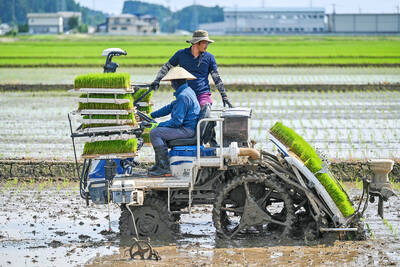An Australian politician has used his first speech to parliament to call for unemployed people to be stung with a cattle prod to get them to work.
John Williams, a former truck driver, shearer, farmer and small business owner who only took his place in the Senate on July 1, said he had seen many people living on unemployment benefits who were “determined not to work.”
“They are simply getting a free ride on behalf of the tax payers of Australia and it is about time they received a touch on the backside with a cattle prodder to get them off their butts and actually do some work,” he said.

PHOTO: EPA
The 53-year-old, a member of the rural-based National Party, said those who were capable of working should not receive dole money unless they made some contribution to society.
“I believe that if you are in good health and are capable of working, then you should work,” he told the Senate.
“However, I do believe that the genuine unemployed should have a safety net and should be helped through their tough times until they find employment.”(AFP)
澳洲一位政治人物在國會第一次發言時就語出驚人地表示,要用趕牛棒戳一戳那些無業遊民,趕他們去工作。
曾當過卡車司機、剃羊毛的人、農夫且自己經營過小生意的約翰.威廉斯,今年七月一日才就任參議員。他說他見過許多靠領鼓勵就業津貼過活的人,是「抱定不去工作的打算」。
他說:「他們全靠搭澳洲納稅人的順風車過活,該是有人從背後用趕牛刺棒戳戳他們,趕他們起身去做些工作的時候了。」
身為以農業為本的國家黨黨員,這位現年五十三歲的議員表示,那些有能力工作的人不該領取失業救濟金,除非他們對社會有某些貢獻。
他在參議院發言時表示:「我認為如果你身體健康,又有工作能力,你就應該工作。」
「然而,我也認為應該要為那些真正失業的人建立一套安全的機制,在他們找到下一份工作前,幫助他們度過生命中的難關。」
(法新社�翻譯:袁星塵)

Rice is essential to Japanese culture, tradition and politics. People take pride in the oval-shaped sticky Japonica grain, which is still a staple even though total consumption has fallen over the decades. But since last summer, prices have soared as supplies have fallen short of demand. The government has long paid farmers to cut back on rice acreage, and change to other crops to keep rice prices relatively high. To cope with shortfalls this year, the government has released rice reserves. But the grain has been slow to reach supermarket shelves. Anger over that was part of the reason the Agriculture Minister

In Taiwan, 7-Eleven convenience stores can be found on almost every street corner. With over 84,600 stores across 20 countries, 7-Eleven has more locations than any other retail business on Earth. For millions of people, the chain is an important part of daily life, providing coffee, quick meals, and essential items for those __1__. The history of 7-Eleven began nearly 100 years ago in Dallas, Texas. In 1927, the Southland Ice Company began selling blocks of ice that were used to keep fridges cool. Shortly after opening, the company __2__ its offerings to include groceries like milk, eggs, and

Step into any corner of Turkiye, and you’ll likely encounter the iconic “Evil Eye,” known as “nazar boncu?u” in Turkish. This striking blue glass ornament is shaped like an eye with concentric circles of dark blue, white, and light blue. While its name in English suggests something threatening, it’s actually a charm designed to ward off misfortune. The origins of the nazar boncu?u can be traced back to ancient Mediterranean and Middle Eastern traditions. The word nazar comes from Arabic, meaning “gaze,” while boncu?u translates to “bead” in Turkish. Central to the nazar boncu?u’s mythology is the idea that

Continued from yesterday(延續自昨日) https://www.taipeitimes.com/News/lang In 1946, the company adopted the name 7-Eleven to reflect its newly extended __3__, from 7am to 11pm, a novel concept at the time. As a rapidly growing company, it began offering franchise opportunities in the 1960s. In 1974, the first 7-Eleven in Japan was opened by the supermarket company Ito-Yokado. The Japanese franchises were __4__ successful that by 1991, Ito-Yokado was able to acquire a 70 percent stake in Southland Corporation. Its investments eventually resulted in full ownership of 7-Eleven, which paved the way for the Japanese company to enter the international market. Since then, 7-Eleven